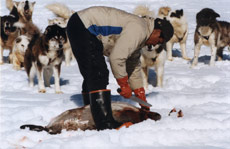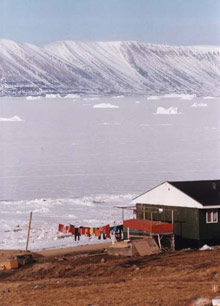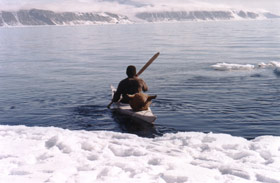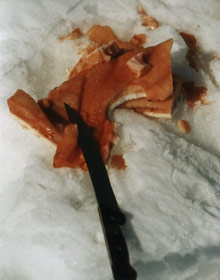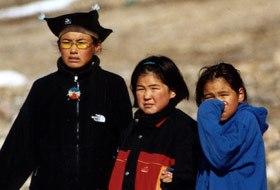|
 (Photo: Marla Cone) (Photo: Marla Cone) 
It could effect their memory, vocabulary, other cognitive skills, but also their immune system. It could weaken their immunity, and there are a lot of illnesses in the arctic -- a lot of ear infections, especially, which can cause hearing loss. And so scientists say these contaminants could be an explanation for the high disease rates in the arctic among children.
CURWOOD: So what you’re saying is that one of the things that these chemicals can do is impair immune systems, and there are a number of diseases that they’re seeing around hearing. What specifically are they seeing?
CONE: They’re mostly concerned about infections, respiratory infections and ear infections, otitis. The number of otitis, or ear infections, is very high in arctic children.
CURWOOD: Now, what about brain development? In the United States there have been studies that show that children of mothers who have been exposed to things like PCBs tend to have some differences in their intelligence and also in their emotional steadiness – some work out of the Great Lakes. Anything like that showing up in these children of the arctic?
CONE: Yes, there have been similar studies in the arctic, although they are smaller studies, fewer people. The logistics of this is very difficult to study these children. They have found similar effects from PCBs and the Inuit children of Canada. They found some memory-type issues in infants. But they’re still looking.
CURWOOD: What kind of studies did they do, exactly? Do you know?
CONE: Well, they did one study of 11-month-old babies in Nunavik, Canada. They repeatedly showed them a picture, and researchers recorded how readily these babies could recognize images they had already seen. This is a pretty standard test of measuring a child’s IQ, a baby’s IQ. And the infants with high amounts of PCBs in their bodies were 10 percent less likely to recognize the images than the infants with low PCB levels.
CURWOOD: I’m also wondering if people behave any differently. Some of these chemicals are considered to be neurotoxins, and can affect people’s emotional affect as well as their intelligence. What things are being seen, if any, along these lines? In terms of, say, learning disability or even delinquency?
CONE: There’s been no studies of that to date, any of the behavioral issues. And the neurological issues are pretty tricky to try to study in the arctic. Not only are there logistical issues of getting enough children, but there’s also the other social issues that could play into a child’s intelligence.
Any drinking by the mother – drinking, alcoholism is very high in the arctic. And they do say that the neurological effects they found on these infants are similar in scope to what they would expect if a mother had been drinking moderate amounts of alcohol. In other words, the effect is about the same. Just eating their foods, their natural, traditional foods, can have the same effect as if they were drinking while pregnant.
CURWOOD: Now, I also understand that you’ve been looking at what’s happening to some of the largest predators in the arctic, aside from people. And that at one point you actually were tracking polar bears in some of the Norwegian islands way, way up there, far off the northern coast of Norway. What was it like being with some of these scientists who know how to find polar bears?
CONE: These scientists are an amazing, hardy crew. They take their life in their hand to do this type of work. There’s a man named Andy Derocher who’s now working for Canada, who every spring they would spend a full month going up in helicopters in these Norwegian islands called Svalbard. And they’re up there tracking these polar bears, tranquilizing them, landing in their helicopter, and taking their fat and blood samples so they can see how contaminated they are.
They found some very weird things happening with those polar bears. There seems to be a whole missing generation of mothers from about 15 to 20 years ago. They just don’t seem to be around, and they’re not sure why. They think that perhaps they’re not denning, they’re not having cubs. So there could be fertility issues regarding the PCBs in these polar bears.
CURWOOD: First of all, what’s in their blood? What are they finding in their blood?
CONE: PCBs is the highest contaminant. That’s the most problematic one. There are about 200 chemicals in the polar bears, but PCBs are the ones that are considered the biggest problem.
CURWOOD: And what do they do to the hormones, to the natural chemicals in the bears?
CONE: They certainly mess up the hormones. Their testosterone levels are lower. They also affect the thyroid, and thyroid hormones are what help the brain develop.
CURWOOD: Sometimes these chemicals are linked to changes in the physical, sexual organs of animals. What, if anything, along those lines is showing up in polar bears?
CONE: They have found over the past few years a small number of half male, half female mothers. Some of them are still able to have cubs. But they do have some male reproductive parts and some female reproductive parts.
CURWOOD: I’m not sure I’d want to check that on a polar bear.
CONE: [Laughing] The scientists did show it to me. I couldn’t tell the difference, frankly, but they could.
CURWOOD: And so the polar bear is at this point is sedated? What do they do?
CONE: Yes, they sedate the adults. They fire tranquilizer guns from the helicopter, we’re about 10 feet off the ground, the helicopter is spinning, there’s snow flying. It’s just an amazing thing. It really feels like that helicopter is crashing, not landing. These are amazingly skilled pilots up there.
Usually they have a mom and some cubs. This is denning time, they just came out of the dens. So when the mother is down, they will land. And these cubs are four months old. And very few human beings have seen cubs in the wild that are that young. They’re adorable. They’re about 40 pounds, 35-40 pounds. They’ll lick your fingers. They’ve never seen a human being before. And they’re sort of wondering why their mother is snoozing there while all this excitement is happening.
CURWOOD: At this point they’re teddy bears, huh?
CONE: Yeah, they’re amazing, they’re just wide-eyed. And then they do have to – they sample their blood. They try to take it easy on the cubs. But then they tranquilize them before they take off on the helicopter, because they don’t want the cubs to wander off without the mom. At this point they cannot fend for themselves.
CURWOOD: And in a way, Marla, I take it that the story of the polar bears is similar to the initial discovery of what’s in the Inuit breast milk. In your articles you wrote that this Canadian researcher, this gentleman you were with, Andrew Derocher, had, what, wanted to study polar bears in Norway because he thought they would be a pure – virgin, if you would -- population? But I guess it didn’t turn out that way.
CONE: Right, it’s like a carbon copy of what happened with the human breast milk. He really wanted to go to Svalbard because it’s in the middle of nowhere, nobody expected to see high contaminant levels. It was a population of bears that was not hunted, unlike in Canada and some other areas. And so he was pretty shocked when he arrived and saw these high contaminant levels, and these hermaphroditic bears and these other problems.
CURWOOD: This is what may be happening with the bears, and you’ve told us some about what’s happening with the people, but talk to me a little bit about the options here. I mean, what do people do if they want to eat something different in many villages? It doesn’t sound to me like they have many options, frankly.
CONE: And that’s the dilemma. They don’t really have any options, at least healthy, nutritious options. They can go to their little village store. There will be imported food there. In Greenland it will be Danish food, in Canada, in Nunavik and Nunavut, it would be Canadian food. There are options, but they’re expensive. They’re processed foods, they’re not good for their hearts, they’re not good nutritionally.
So most arctic experts tell the Inuit to keep eating their traditional foods. There has been an effort in Nunavik, in Canada, to get people to eat more arctic char, a fish which is much lower on the food chain and full of good fatty acids, rather than beluga whale, which is very high on the food chain.
CURWOOD: And what about the young people? How much do they eat compared to the way their elders do?
CONE: The young people eat far less traditional foods than older people, and that’s just a fact of modernization. It really doesn’t have much to do with the contaminant loads.
CURWOOD: If young people are eating far less traditional foods, I wonder if this doesn’t end up helping the question of contamination?
CONE: The contaminants probably will decrease over time. Many of them already are decreasing, like PCBs. Others are increasing, like mercury. But if young people do eat more imported foods and stop eating their traditional foods, yes, their contamination levels will go down. But that does not mean their health will improve. If they’re eating a lot of processed foods, you’re talking about heart disease and diabetes and other problems.
CURWOOD: Now, some would say that climate change is related in that people in the arctic are seeing the effects of it a lot more rapidly than other places on the planet -- and this too comes from industrialized society. It sounds to me like these people are sort of having a double-whammy. As I understand it, the ice is shrinking there, certainly the thickness of it is shrinking in the high arctic. This has to affect their ability to hunt, and also the conditions for some of their prey. And they have these chemicals, as well, to deal with.
CONE: Yes, absolutely. And that is something that is more visual for them, more tangible. They see the melting of the ice, they know it’s harder to find their prey. And that is probably more of a concern for them than the contaminants, because these contaminants are invisible. They cannot see them, not sure they believe it, but they’re there.
CURWOOD: Marla, before we go, this is very difficult to look at, the question of people and animals really under assault from chemicals. What are the ways out? What are people doing to try to remedy this?
CONE: Oh, I guess I would have to say they know how to survive the arctic, they’ve learned it through countless generations, they’ve been through bad times before. Settlers brought horrible plagues and diseases to them a couple centuries ago, and they’ve survived that. I do believe that they will survive this. This is probably one of the worst environmental injustices in the world, one of the worst that I’ve come across. People who have now power over what is happening to their culture and their diet and their health. But the arctic people have the will to survive.
CURWOOD: Marla Cone is a reporter for the Los Angeles Times. She’s working on a book – you don’t have a title for the book yet, Marla?
CONE: No, I don’t.
CURWOOD: But when it comes out it will be about this subject, about the time that she spent in the high arctic. Thanks so much for taking this time with me today.
CONE: Thank you, Steve.
[MUSIC: Peter von Heineken “Slug” SLUG SOUNDTRACK (Island Records – 1995)]
Back to top
CURWOOD: Five electric power companies from across the country have announced dramatic cuts in emissions of carbon dioxide to help stem global warming. That’s the kind of voluntary action on climate change favored by President Bush, who backed away from a campaign pledge to cap emissions of the greenhouse gas. But the power companies also voiced support for mandatory limits on CO2 – the kind of regulation the president has repeatedly rejected. Jeff Young reports from Washington on this change in the business climate.
YOUNG: Roger Duncan’s from Texas. He’s in the energy industry. And he’s traveled to Washington to talk about big government and global warming.
DUNCAN: Today we join the World Wildlife Fund in supporting mandatory carbon controls on all utilities.
YOUNG: Not quite what you’d expect from deep in the heart of Texas, where Duncan is vice president of Austin Energy. Austin is among five power companies and utilities publicly voicing support for a government cap on carbon dioxide. In a program arranged by the World Wildlife Fund, the companies also pledge to dramatically cut CO2 output over the next 15 years by increasing efficiency or using more renewable energy. That regulatory approach to climate change is quite different from what another former energy businessman from Texas proposes. President Bush prefers voluntary programs to reduce CO2. Duncan says that’s not enough.
DUNCAN: We reached the conclusion that the voluntary efforts that all of us were participating in, and other utilities were participating in, that those voluntary efforts were just not sufficient to attain the type of reductions that we felt were necessary to address the problem.
YOUNG: Duncan sees voluntary programs as a business-as-usual approach that will not reduce CO2 levels. Utilities from Sacramento, California; Burlington, Vermont; and Waverly, Iowa, also signed on, as did FPL group of Florida. FPL is among the country’s biggest power companies, with plants in 24 states. Vice president Randy Lebow says it was a bottom line decision.
LEBOW: We think that being cleaner, producing clean energy for our customers, preparing for the future in mitigating those risks is the way to build a good business and be competitive in the marketplace.
YOUNG: Improvements in efficiency can be the cheapest way to meet growing power demand, especially compared to the cost of building new power plants. The World Wildlife Fund’s Rebecca Eaton says there’s also a growing realization among business leaders that some kind of carbon cap is probably coming. Eaton says power companies can’t plan effectively until they know what form it will take.
EATON: My sense from speaking with companies – these and other electric power companies behind closed doors – is that they really are seeking business certainty, and they want to know what the future regulatory requirements are going to be so they can invest properly.
YOUNG: But most power companies are not ready for regulation. The Edison Electric Institute represents about 200 power companies producing 70 percent of the country’s electricity. Edison electric spokesperson Dan Riedinger says mandatory cuts might work for companies using hydro, wind or natural gas. But carbon-intensive coal provides half the country’s electricity.
RIEDINGER: Every company, every power company, wants business certainty. But imposing a carbon cap that the vast majority of power companies simply cannot meet -- other than by taking drastic action in terms of fuel switching, which really may not be feasible – that’s not the kind of certainty we need.
YOUNG: Riedinger says his member companies debate this issue but agree that voluntary emissions cuts are the way to go until new technology can cut CO2 . Austin Energy’s Duncan says he’ll probably take some heat from fellow power producers for breaking ranks on the carbon cuts. But he predicts it won’t be long before others follow his lead.
DUNCAN: I believe that in the ten to 20 year timeframe that all utilities are gonna have to do what Austin Energy and a few other utilities are doing today, in terms of investments in energy efficiency and renewables. I believe that their own customers will be demanding those types of programs from their utilities.
YOUNG: World Wildlife officials expect more power companies to join the call for a CO2 cap – enough, they hope to inspire some change in the political climate as well. For Living on Earth, I’m Jeff Young in Washington.
CURWOOD: Coming up: public safety and official accountability in coal country. We have a special investigative report. So, stay tuned to Living on Earth.
ANNOUNCER: Support for NPR comes from NPR stations, and: Aveda, an earth-conscious beauty company committed to preserving natural resources and finding more sustainable ways of doing business. Information available at Aveda.com; The Noyce Foundation, dedicated to improving math and science instruction from kindergarten through grade 12; The Annenberg Foundation; and, The Kellogg Foundation, helping people help themselves by investing in individuals, their families, and their communities. On the web at wkkf.org. This is NPR, National Public Radio.
[MUSIC: Thomas Newman “Dead Already” AMERICAN BEAUTY SOUNDTRACK (Dreamworks - 2000)]
Back to top
CURWOOD: It’s Living on Earth, I’m Steve Curwood. Coming up: public safety and official accountability in coal country. We have a special investigative report. First this note on emerging science from Jennifer Chu.
[SCIENCE NOTE THEME]
CHU: For a number of years, scientists have suspected that clouds carry more pollution across the sky than wind alone. Now, a new study by NASA scientists demonstrates this is true. Researchers took air samples of cloudy and clear air during twenty flights near the coastline of Asia. They checked for pollutants such as carbon monoxide, carbon dioxide, and methane. And they found almost a third more pollutants in the cloud cover than in the clear.
Scientists believe this occurs because human activities like burning fuel for heat or industrial purposes emit such pollutants as carbon monoxide. Cold fronts move in and lift warm, polluted air up. This same lifting of warm air causes the cloud formations. So the pollution of air is lifted right into the clouds. The discovery that clouds carry a heavier load of pollution is important in understanding regional flow of contaminated air.
Recently, satellites have begun to monitor the flow of pollutants such as ozone and carbon monoxide. But the satellites are unable to get as accurate a reading when blocked by cloud cover. So researchers conclude that based on this study, both satellites and actual air testing will be necessary to monitor the flow of pollution from one area to another. That’s this week’s note on emerging science, I’m Jennifer Chu.
Back to top
CURWOOD: Last November, "Living on Earth" interviewed mine safety official Jack Spadaro. He's the whistleblower who alleges that officials from the Bush Administration obstructed the investigation into one of the worst environmental catastrophes in the history of the southeastern United States: The Martin County Coal slurry spill of October 2000.
Mr. Spadaro was placed on administrative leave last summer, and the U.S. Department of Labor has taken steps to fire him. But now some members of Congress are looking for answers about the role the government has played in his dismissal and about the coal slurry investigation itself. Phillip Babich has our report.
[STEADY RATTLING OF MACHINE]
 |
 |
|

A "coal bucket" heading down a county road in Inez, Kentucky. (Photo: Phillip Babich) 
BABICH: It's a crisp day in Inez, Kentucky. Trucks hauling coal – gray-stained rigs known as "coal buckets" – wend their way up a narrow county road in regular intervals.
[COAL TRUCKS ON THE MOVE, GROWLING BY ONE AFTER THE OTHER]
BABICH: Their payload is from the Martin County Coal Company, just down the road. Monroe Cassady used to work for Martin County Coal in the preparation plant. That's where they wash the raw coal.
CASSADY: Yeah, they're running the coal, and you can see the smoke stack comin' out where the heat dryer and scrubber and everything's a'working. You can see the 'dozers in the coal pile, and coal coming out the stacker tubes. Yes, it's a typical day at a coal mine.
BABICH: In the preparation plant, the raw coal goes through a series of chemical processes to separate out dirt and rock. The excess material, water and chemicals – the slurry – is then pumped into an impoundment. The Martin County Coal slurry impoundment is 70 acres in size -- that's more than half-a-mile long, and about three-and-a-half football fields across. It has a capacity of more than 2 billion gallons. Part of the lagoon is situated above underground mines. In the early morning hours of October 11, 2000, the bottom of the slurry impoundment broke into one of the mines.
CASSADY: The slurry came down this stream right here, where we're lookin' at right here
BABICH: A torrent of sludge and water blasted through about two miles of underground mines until the flood punched out of a mine opening in the side of a mountain and began flooding Coldwater Creek. Another pressure build-up resulted in a second flood on the Wolf Creek side of the impoundment. Residents described the flood as a black lava flow, with enough density to raise bridges as it crested the creek banks. Again, Monroe Cassady.
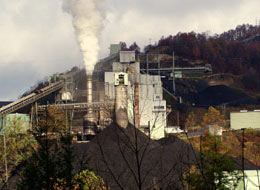 |
 |
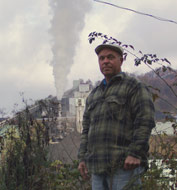 |
|

Martin County Coal Company, Inez, Kentucky (Photo: Phillip Babich)
|
 |
 Former coal worker Monroe Cassady in front of Martin County Coal Company (Photo: Phillip Babich) Former coal worker Monroe Cassady in front of Martin County Coal Company (Photo: Phillip Babich) 
CASSADY: When it came out on one side of the mountain it shot plum across to the other side a'knockin' big timbers down. So with all that force a'comin' out you can just imagine what it would look like comin' through here. Nothin' but black, you know.
MAYNARD: It smelled terrible. It smelled like chemicals, like hydraulic. You know, nothing smells worse than hydraulic fluid.
BABICH: Janice Maynard lives on Coldwater Creek. The smells from the day of the accident are still fresh in her mind. So are some vivid scenes. One memory in particular is of five turtles lying on top of the slurry.
MAYNARD: When I saw all the big turtles on the surface there, you could see every one of them, their shells. Big, big turtles. And they were dead, though, you know.
 |
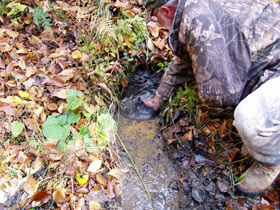 |
|
 An Inez resident scoops out slurry-contaminated water from an old drinking hole, which is still blackened three years after the October 2000 slurry spill. (Photo: Phillip Babich) An Inez resident scoops out slurry-contaminated water from an old drinking hole, which is still blackened three years after the October 2000 slurry spill. (Photo: Phillip Babich) 
BABICH: More than 300 million gallons of the slurry fouled about 100 miles of waterways, causing severe property damage and annihilating wildlife. So what went wrong at Martin County Coal?
Jack Spadaro is an expert on coal slurry impoundments, and was on the federal investigation team that examined the Martin County disaster. It was a 1972 slurry dam accident at Buffalo Creek in West Virginia that has defined Spadaro's career in mine safety. One hundred and twenty-five people were killed and 4,000 left homeless in that accident.
At 23 years of age, Spadaro was tapped to be the staff engineer in the investigation of the Buffalo Creek disaster. He spent the next 30 years studying rock and earth structures and working as a government regulator. When he first heard about the Martin County catastrophe, Spadaro feared the worst.
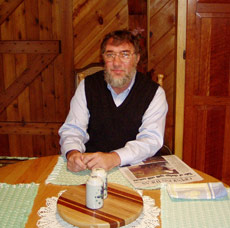 |
|
|

Mine safety official Jack Spadaro in his home in Hamlin, West Virginia (Photo: Phillip Babich) 
|
 SPADARO: I was concerned that we were having, thirty years after Buffalo Creek, a failure of this magnitude. And, I knew what kind of tragedy could result if we didn't do a good job of investigating and finding out what really caused this.
SPADARO: I was concerned that we were having, thirty years after Buffalo Creek, a failure of this magnitude. And, I knew what kind of tragedy could result if we didn't do a good job of investigating and finding out what really caused this.
BABICH: Federal regulations require at least 150 feet of rock and dirt lie between the bottom of a slurry impoundment and an underground mine. Spadaro's investigative team discovered only 15 feet.
WILSON: Frankly, I was surprised that they were operating, because I kind of thought that they stopped operations after the previous failure.
BABICH: Larry Wilson was a lead federal mine safety engineer following a rupture at the Martin County Coal impoundment in May 1994 that dumped 100 million gallons of slurry. He surveyed the damage and made a list of nine critical recommendations, including fortifying the impoundment and underground mines before Martin County Coal could continue to dump slurry there.
WILSON: I didn't think they would be able to continue operating unless they did seal these things, pretty much knowing full well that they wouldn't seal them because it would cost too much to do so. I guess I was trying to back-door into making sure that the site was never used again.
BABICH: Massey Energy, the parent company of Martin County Coal, did not respond to repeated requests for an interview. But Bill Caylor, president of the Kentucky Coal Association, which represents the state's coal operators, says Massey did all it could to prevent another accident.
CAYLOR: It's really easy to say on hindsight, ‘oh, we should have known.’ At the time they thought they were doing things correctly. I don't think anybody felt like they were not reacting properly.
BABICH: But documents obtained through Freedom of Information Act requests show that district officials for the U.S. Mine Safety and Health Administration, MSHA, and Martin County Coal, did not comply with Wilson's recommendations even though the company continued to use the impoundment and add to its capacity. MSHA officials declined to comment for this story. Wilson's June 1994 report was unearthed in late-2000 when then-head of MSHA Davitt McAteer, a Clinton appointee, ordered a complete review of his agency's files on Martin County Coal.
MCATEER: By virtue of the fact that we had a second failure, it means that our response wasn’t adequate. There was no question that the district managers could have been more stringent and more demanding of the company to take further steps to increase the impoundment safety and security.
BABICH: Spadaro and other investigation team members felt they were beginning to collect enough evidence to issue Massey Energy citations for willful and criminal negligence. Both the Wilson memo and a critical independent engineering report were red flags to Spadaro that Martin County Coal was at fault.
SPADARO: The company knowingly continued to pump slurry into a reservoir that was underlain by mine workings. And there was a thin soil and rock cover that was known because there had been a previous breakthrough. And the company submitted drawings that misrepresented the underground conditions.
BABICH: In addition, it looked as though the team's own agency, MSHA, a wing of the Department of Labor, was going to be held accountable as well. But that all changed when George W. Bush moved into the White House.
BUSH: [FROM INAGURATION] I George Walker Bush do solemnly swear…that I will faithfully execute the office of President of the United States…
BABICH: Within days of President Bush's inauguration a new team leader, Tim Thompson, was brought in to head the Martin County Coal investigation. According to Jack Spadaro and other members of the investigation team who spoke on condition of anonymity, Thompson dramatically narrowed the scope of the investigation. Witnesses were dropped. MSHA's culpability in the matter was taken off the table. What's more, says Spadaro, Thompson was in close contact with President Bush's new MSHA chief, Assistant Secretary of Labor Dave Lauriski, particularly when mine safety engineer Larry Wilson's 1994 recommendations were discussed.
SPADARO: And he would come back and he would say, we're going to take this section of the report out. We're not going to have any reference to the 1994 recommendations by the technical support division.
BABICH: By April of 2001 Spadaro was fed up with what he saw as an emerging cover-up. He tendered his resignation from the accident investigation team and filed a complaint with the Department of Labor's Office of the Inspector General, alleging that Bush administration officials were obstructing the team's work.
Spadaro also spoke out publicly when MSHA released its final accident investigation report in October 2002, which cited Martin County Coal for two minor violations with fines totaling $110,000, and left MSHA district officials completely off the hook. One of those citations was dropped, and the penalty on the other was reduced. Massey is now looking at a $5,500 dollar fine.
The final accident report said the cause was an inadequate berm of coal refuse around the perimeter of Martin County's impoundment.
SPADARO: There was a lot of pressure on all the folks on the team to kind of go along with the program, and get this report out and make it as smooth as possible. And, don't argue about the causes of the accident.
BABICH: Some eight months later, on June 4, 2003, Spadaro was placed on administrative leave. Right now he is awaiting final word as to whether he will retain his job as Superintendent of MSHA's training facility. His superiors are accusing him of a raft of misbehaviors – unrelated to the investigation – including "abusing his authority" and "failing to follow instructions." Spadaro says that he's being targeted for his whistle blowing activities.
SPADARO: I've been in government 27 years, in federal government, and I was in state government five or six years. This is the most lawless administration I've ever seen. They run roughshod over anybody who might try to get them to obey the laws.
BABICH: The Department of Labor Inspector General exonerated MSHA of any wrong doing in its handling of the Martin County Coal investigation. But whole sections of the IG's report are blanked out, and some say it raises more questions than it answers. Some members of Congress are trying to get to the bottom of the whole affair, including the pending dismissal of Jack Spadaro.
OWENS: It's a political item which has come down from the top.
BABICH: U.S. Representative Major Owens of New York and two other Democratic members of the House Committee on Education and the Workforce are taking a closer look at Jack Spadaro's case. They've requested that U.S. Secretary of Labor Elaine Chao provide them critical documents and information to help them assess whether Spadaro is being wrongly terminated. So far, says Representative Owens, their investigation has been “stonewalled.’
OWENS: Somebody had to get to the secretary, or the secretary had to receive that order from some political forces that did not want to see this happen for their own various reasons, in terms of cowing to Martin County Coal Company. Or they felt some kind of indebtedness to them.
BABICH: Department of Labor spokesperson Ed Frank denies that Secretary Chao has had a hand in the Spadaro case or the investigation. He says that the Department is in the process of getting the documents to Representative Owens.
FRANK: The Secretary played absolutely no role in the personnel issue with Mr. Spadaro, who is a mid-level employee in West Virginia. And the Department's fine against Martin County Coal is the largest that's allowed under federal law and the facts of the case.
BABICH: While it's unclear whether Bush Administration connections to the mining industry have anything to do with the investigation or personnel actions taken against Spadaro, it's probably worth noting that Massey Energy is a major contributor to the Republican Party.
And, President Bush's top leadership at MSHA is stacked with former mining executives. Assistant Secretary Lauriski was an executive with Energy West Mining. Deputy Assistant Secretary John Correll, worked for Amax Mining and Peabody Coal.
One MSHA investigator told me, "The investigation didn't have to do with just Martin County Coal. The bigger question is, should slurry impoundments be allowed over old mines? That would have been addressed in our report.” With an estimated 240 such impoundments across the country, the coal industry had a lot riding on MSHA's report.
[REVVING ENGINE OF PASSING TRUCK, SOUNDS OF FALLING WATER IN FOREGROUND]
BABICH: The question of safety seems very real when you stand below a slurry dam. A typical rock and earth structure, about 250 feet tall, stretches to the top of a valley mouth to hold back slurry at Independence Coal, another Massey subsidiary based near Whitesville, West Virginia. A truck driving across the top of the dam looks the size of a toy Hot Wheels vehicle. Directly across a creek is an elementary school where 200 students are enrolled. Freda Williams, an organizer with the advocacy group Coal River Mountain Watch, shudders at the thought of a slurry accident here.
WILLIAMS: I would really hesitate to say what would happen to all those students because no one knows what to do. They only thing you know to do is run.
BABICH: This impoundment is just one concern for communities in and around Whitesville. What looms most ominously for them are plans to make the largest impoundment in the country at Brushy Fork. It now holds 5 billion gallons of slurry, and, according to Coal River Mountain Watch, it's scheduled to hold up to 9 billion gallons. Its dam is 950 feet tall and it sits on top of underground mines. With such a massive impoundment in their backyard, Freda Williams says it's important for regulatory agencies to be vigilant.
WILLIAMS: We just want the coal mining to be done legally and responsibly. We’re not against coal mining.
BABICH: And that's been Jack Spadaro's philosophy since his early days at Buffalo Creek. His fate is now in the hands of his bosses at MSHA, who are weighing the superintendent's appeal of his termination notice. Spadaro doesn't expect any sympathy, though. He's levied charges that MSHA's top officials are handing out lucrative no-bid contracts to friends and associates. For Living on Earth, I'm Phillip Babich.
CURWOOD: Support for our story on Jack Spadaro and the Martin County Coal slurry spill was provided by the Fund for Investigative Journalism.
[MUSIC: Mark Isham “Coalwood” OCTOBER SKY SNDTRK (Sony Music - 1999)]
Related links:
- "Dirty Business"
- "Wrongful Termination of Coal Mining Official?"
- "Shafted" Back to top
CURWOOD: And for this week - that's Living on Earth. Next week – it’s not easy to track the way water moves underground. But researchers at Ohio State University have come up with a clever computer model that sheds new light on how pollution reaches drinking water supplies, and may prevent it from happening in the first place.
MAN: The kind of model that was done here, the level of sophistication and how the analysis was done, will absolutely have application to many other cases out there -- and unfortunately, there are too many of these cases. There isn’t a community that doesn’t have one, or is under the threat of having one.
CURWOOD: When science meets technology – next time on Living on Earth. And between now and then you can hear us anytime and get the stories behind the news by going to livingonearth.org. That’s livingonearth.org.
And just a reminder that Living on Earth is giving one listener and a guest the chance to win a spot on our upcoming African safari. To be entered in the sweepstakes automatically, please visit livingnearth.org and become a member. Or, mail a three by five card with your contact information to 20 Holland Street, Suite 408, Somerville, MA, 02144.
The sweepstakes is open to all legal residents of the U.S. and Canada aged 18 and up – except those employed by Living on Earth, NPR, or the stations that broadcast this program. All entries must be received by March 1, 2004. One entry per person, please. The winner will be selected in a random drawing. The estimated value of this prize is $7,000, which includes airfare from New York City. Visit livingonearth.org for details on this exciting trip.
[EARTH EAR: Jim Metzner “Arctic Ice” PULSE OF THE PLANET (Pulse of the Planet – 2002]
CURWOOD: Before we go – one last stop in the way frozen north.
[ESCALATING REVVING SOUNDS, LIKE RADIO-CONTROLLED CARS HITTING TOP SPEED WHILE DRAG-RACING]
CURWOOD: Strange and wondrous sounds can happen when giant ice floes bump into each other - as two of them did one day in the Arctic Ocean. Robert Asher was there to record the action for the Pulse of the Planet.
[ REVVING SOUNDS CYCLING BETWEEN A DEAD HALT AND SUSTAINED HIGH SPEED PITCH]
CURWOOD: Living on Earth is produced by the World Media Foundation. You can find us at livingonearth.org. Our staff includes: Nathan Marcy, Susan Shepherd, Carly Ferguson and Tom Simon. We had help this week from Rosalyn Fay and the National Radio Project. Al Avery runs our website. Our interns are Christopher Bolick and Nal Tero. Special thanks to Ernie Silver. Alison Dean composed our themes. Environmental sound art courtesy of EarthEar. I’m Steve Curwood. Thanks for listening.
ANNOUNCER: Funding for Living on Earth comes form the National Science Foundation, supporting coverage of emerging science; and Stonyfield Farm – organic yogurt, cultured soy, and smoothies. Ten percent of their profits are donated to support environmental causes and family farms. Learn more at Stonyfield.com. Support also comes from NPR member stations, the Ford Foundation, for reporting on U.S. environment and development issues, and the Geraldine R. Dodge Foundation.
ANNOUNCER: This is NPR, National Public Radio.
This Week's Music
Living on Earth wants to hear from you!
Living on Earth
62 Calef Highway, Suite 212
Lee, NH 03861
Telephone: 617-287-4121
E-mail: comments@loe.org
Donate to Living on Earth!
Living on Earth is an independent media program and relies entirely on contributions from listeners and institutions supporting public service. Please donate now to preserve an independent environmental voice.
NewsletterLiving on Earth offers a weekly delivery of the show's rundown to your mailbox. Sign up for our newsletter today!
 Sailors For The Sea: Be the change you want to sea. Sailors For The Sea: Be the change you want to sea.
 The Grantham Foundation for the Protection of the Environment: Committed to protecting and improving the health of the global environment. The Grantham Foundation for the Protection of the Environment: Committed to protecting and improving the health of the global environment.
 Contribute to Living on Earth and receive, as our gift to you, an archival print of one of Mark Seth Lender's extraordinary wildlife photographs. Follow the link to see Mark's current collection of photographs. Contribute to Living on Earth and receive, as our gift to you, an archival print of one of Mark Seth Lender's extraordinary wildlife photographs. Follow the link to see Mark's current collection of photographs.
 Buy a signed copy of Mark Seth Lender's book Smeagull the Seagull & support Living on Earth Buy a signed copy of Mark Seth Lender's book Smeagull the Seagull & support Living on Earth
| | | | |
